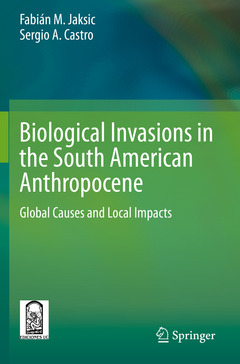Description
Biological Invasions in the South American Anthropocene, 1st ed. 2021
Global Causes and Local Impacts
Language: English
Subjects for Biological Invasions in the South American Anthropocene:
Publication date: 04-2022
346 p. · 15.5x23.5 cm · Paperback
Publication date: 04-2021
346 p. · 15.5x23.5 cm · Hardback
Description
/li>Contents
/li>Biography
/li>Comment
/li>
This book provides a conceptually organized framework to understand the phenomenon of biological invasions at the Anthropocene global scale. Most advances toward that aim have been provided from North American and European researchers, with fewer contributions from Australia and South Africa. Here we fill the void from the Neotropics, focusing on the research experience in South American countries, with a strong emphasis on Argentina and Chile.
The text is divided into two parts: The first half comprises self-contained chapters, providing a conceptual, bibliographic and empirical foundation in the field of invasion biology, from an Anthropocene perspective. The second half reviews the ecology, biogeography, and local impacts in South America of exotic species groups (European rabbit, Eurasian wild boar, Canadian beaver, North American mink, and Holarctic freshwater fishes), which are shown to be useful models for case studies of global relevance.Fabián M. Jaksic has a degree in Biology from the University of Chile, a PhD in Zoology from the University of California (Berkeley), is an American Ecological Society’s Certified senior ecologist, and a member of the Chilean Academy of Sciences. He is currently a professor and director of the Center of Applied Ecology and Sustainability of the Pontificia Universidad Católica de Chile (CAPES-UC), and is the author of over 230 WoS-indexed scientific articles, over 50 book chapters, and of 12 books. Jaksic has also received numerous awards and prizes, including Fullbright and Guggenheim scholarships, Chile’s Presidential Chair in Science, and Chile’s National Prize in Natural Sciences.
Sergio A. Castro holds a B.S. degree in Biological Sciences and a PhD in Biological Sciences with a major in Ecology from the Pontificia Universidad Católica de Chile. He is currently an associate professor at the School of Chemistry and Biology of the Universidad de Santiago de Chile. Castro has developed research in the field of plant ecology and biogeography, as well as on plant and vertebrate invasions. He is the author of 50 WoS scientific articles, of 6 book chapters, and co-author of three books. He is also an associate researcher with the Center of Applied Ecology and Sustainability of the Pontificia Universidad Católica de Chile (CAPES-UC).




